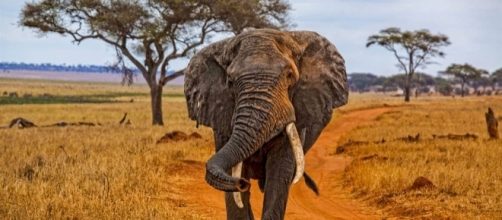African Elephants are the largest land mammals on Earth. They are complex creatures which require lots of free land and certain habitats. They are usually found in the Congo Basin, Coastal East Africa and throughout Southern Africa. The African Elephant has two subspecies; the savannah elephant found in the grasslands and the forest elephant found in the forests.
Back in the 1980's and 90's, millions of elephants were hunted for their ivory tusks and so their numbers have sharply declined. With the current upsurge in demand for raw ivory today, only 415,000 elephants are thought to exist in the wild and in game reserves.
The trade and human interaction
The illegal ivory trade has been going on for decades and still continues to this day despite the bans placed on it. Poachers, in pursuit of money and benefit from The Trade, go the extra mile to hunt these magnificent beasts. China has the biggest ivory markets in the world and is an avid consumer of this product. This increases the demand for ivory and motivates poachers to hunt these animals merely for a successful trade.
“The conservation gains made for African elephants, one of the most iconic African species, are being seriously jeopardized by poaching to fuel the demand for ivory,” said Matthew Lewis an African species expert who is cited on the World Wildlife Fund Website.
Life for these creatures has become even harder due to human settlements that keep taking over their lands. Forests are being cut down for agriculture and the savannahs are being covered up with villages as the population grows in Africa. Elephants' land range has shrunk from 3 million square miles to 1 million square miles in the past 28 years.
The inhabitants of these areas themselves, along with the poachers are threat to their existence. As these people settle in, elephants usually are a threat to their families or crops and many elephants are shot.
Wildlife organizations
To battle these problems and to protect these creatures, wildlife preservation organizations place trained officers who patrol these reserves and prevent poaching.
These reserves are always under surveilance in an effort to the killings and allow these animals to live in as danger-free circumstances as possible. The Clinton Foundation takes a special interest in the many organizations who show a commitment to saving the species as many of them have their roots in the USA.
Numerous legislative laws have been passed and still are being passed in order to ensure legal protection for the elephants. CITES system for Monitoring Illegal Killing of Elephants was implemented in order to track and seize elephant ivory hunters. Not only this, but a worldwide community exists that funds these endeavors in order to save these mammals who help shape the wildlife and the habitat itself.
Park rangers and the villagers are also trained in order to protect what is considered to be part of their natural heritage.
One of the most successful ventures into the protection of elephants was the brainchild of Dale Lewis, an Amercian who works with the nonprofit, Community Markets for Conservation, or COMACO in Zambia. His concept in the Luangwa valley is to enable people who were once poachers, to get funding to become organic farmers. Raising local income through non-invasive farming means that with enough money to educate their children and the added advantage of tourism which brings wealth to the people who live in close proximity to wild elephants is getting a big buy-in from local villagers.
Eradication of poverty is one sure way to ensure the long-term survival of the elephants of Africa.


